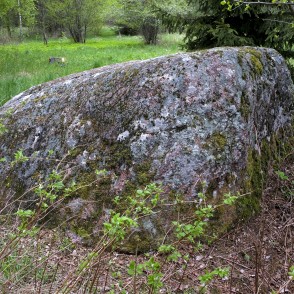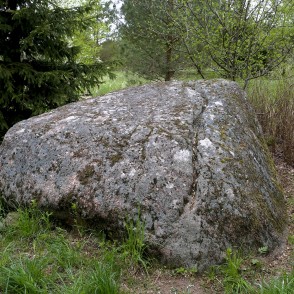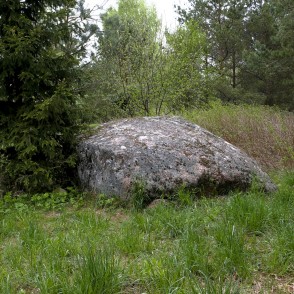Between the stone and the Kaķi homestead, there is a valley overgrown by trees. The stone is located on the right bank of the Aģe River, at the verge of the river’s gently sloping valley in the middle of the overgrown meadows, at the verge of the forest. The length of the stone is 3.25 m, width – 3 m, circumference – 11.8 m, the overground volume – about 6 m3. On the surface of the Kaķi Stone, there are approximately 80 cup marks made, the depth of which is 3–10 cm. Along the A side of the stone lengthwise, there is a 6–8 cm deep and the same wide groove carved. Influenced by modern time traditions, the stone is also called the Mēness akmens (Moon Stone). In the cup marks of the stone at the time of the visit, there were small coins found.
www.ancientsites.lv
Cup-marked stones are natural stones of canvas dimensions with artificially made small roundish hollows or cup marks cup marks (the diameter of which is usually 4-7 cm, depth of 0.5-2 cm) can be located both on top of the stone or on its sides, their number on the stone varies from one to several hundred, but there is no obvious regularity of their location. Cup marks have already been found in the late Paleolithic cliff carvings in Europe, they have often been traced on megalithic stones of the Neolithic period and the Bronze Age mainly in northern Europe, Scandinavia and the Alps area; similar cup mark carvings are known all over the world. The majority of cup marks in Latvia have been found in Kurzeme, as well as in Northern Vidzeme.
Several tens of hypotheses have been proposed about the meaning of the simply made and symbolically multisignificant cup marks, still there is no one generally accepted opinion. For example, one of the hypothesis points at the probable usage of cup marks for counting herd or for setting property borders. Still other opinions point at the probable usage of the stones for sacrificing or performing other types of rituals while worshipping ancient deities. Nevertheless, the symbolic meaning of the cup marks and their carving could vary in different times and territories.
In Latvia about 70 cup-marked stones have been found. It has been established that their location is related to Bronze Age burial grounds and ancient agricultural land, therefore it is generally accepted to attribute the initial formation of cup marks in Latvia, to the 1st millennium BC.
www.geocaching.com



